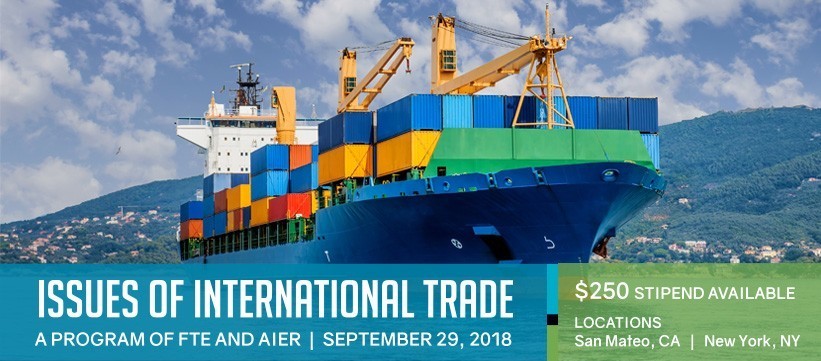Lesson 1 Activity: Tag Check

- >
- Teachers
- >
- Teacher Resources
- >
- Lesson Plans
- >
- Issues of International Trade
- >
- Lesson 1 Activity: Tag Check…
Activity: Tag Check
Download Tag Check guide
Virtual Lesson Slides
Concepts:
| opportunity cost | interdependence | incentive (price) |
| specialization | comparative advantage |
Content Standards:
Standard 1: Productive resources are limited. Therefore, people cannot have all the goods and services they want; as a result, they must choose some things and give up others.
- Choices involve trading off the expected value of one opportunity against the expected value of its best alternative.
- The evaluation of choices and opportunity costs is subjective; such evaluations differ across individuals and societies.
Standard 4: People respond predictably to positive and negative incentives.
- Responses to incentives are predictable because people usually pursue their self-interest.
- Acting as consumers, producers, workers, savers, investors, and citizens, people respond to incentives in order to allocate their scarce resources in ways that provide the highest possible returns to them.
Standard 5: Voluntary exchange occurs only when all participating parties expect to gain. This is true for trade among individuals or organizations within a nation, and among individuals or organizations in different nations.
- Free trade increases worldwide material standards of living.
- Voluntary exchange among people or organizations in different countries gives people a broader range of choices in buying goods and services.
Standard 6: When individuals, regions, and nations specialize in what they can produce at the lowest cost and then trade with others, both production and consumption increase.
- Like trade among individuals within one country, international trade promotes specialization and division of labor and increases output and consumption.
- Individuals and nations have a comparative advantage in the production of goods or services if they can produce a product at a lower opportunity cost than other individuals or nations.
Overview:
Tag Check is a quick way to make students aware of the very real presence of international trade in their daily lives. They will find that most of their clothing is made overseas. (In fact, it will be so rare to find any student who is wearing only American-made clothing that it’s pretty safe to bet $10 that no one in the room is.) As they map where their clothes were produced, they begin to see some of the patterns of specialization that exist in the global marketplace and to realize the extent to which we are tied to this interdependent network of production and trade. The group discussion questions help them to identify the costs and benefits of purchasing and wearing clothing produced in other countries – or of choosing not to purchase and wear clothing produced overseas.
Materials:
- Wall map and a set of push pins or small removable sticky page flags
- Handout (1 per group) or overhead transparency (included in download, linked above)
Time:
- one class period
Procedures:
- Engage the class in a large group discussion: Should we “Buy American?”
- Tell students that you are simply gathering a list of hypotheses and that you will record their answers for later discussion and reflection.
- Encourage students to give reasons to back up their opinions, but stop debate by assuring them that you’ll return to evaluate the opinion list after the small group exercise.
- Divide class into small discussion groups (4 students) and send each group to a separate part of the room where there is space to move a little bit.
- Distribute a discussion record sheet to each group and ask students to designate a discussion leader, a recorder, a mapper, and a reporter for their group.
- Give the following instructions:
- Check the tags on all clothing (except underwear) worn by members of your group. List on your discussion record all the places your outerwear (including shoes, belts, eyeglasses, and jewelry) was made.
- Send the mapper to mark the places on the wall map with push pins or stickies.
- While the mapper is marking, determine whether there is anyone who:
- Is wearing ALL American-made clothing?
- Is wearing NO American-made clothing?
- (Have the recorder list the names of those people (if any) in the appropriate column on the board or overhead transparency.)
- When the mapper and recorder return, answer the discussion questions at the bottom of the discussion record. (You may note answers on the discussion record sheet to help your group reporter, but the record sheet will not be collected.)
- Allow students time to work on the small group task.
- Reconvene the class discussion and ask students to share their findings and conclusions.
- Numbers of students wearing All American or No American-made clothing
- Major incentive for Americans to purchase foreign-made clothing
- Opportunity cost statement explaining why so many Americans wear foreign-made clothing
- Generalization about opportunity cost of NOT having international trade
-
Large group discussion / debriefing: (See suggested answers in teacher guide included in download.)
- Why are so many of you wearing foreign-made clothing? What was your incentive for buying from foreign producers? (For most students, the major incentives will be price and availability.)
- If you are wearing American-made clothing, what was your incentive for purchasing it?
- Choose something that most students are wearing that was produced overseas. (Shirts are usually a good choice.)
- What was the opportunity cost to you of buying a foreign-made shirt?
- What would have been the opportunity cost to you of buying an American-made shirt?
- Did “trading” for foreign-made goods make you better or worse off? Explain how we know that it did.
- Did your purchase of foreign-made goods make our country better or worse off? Explain.
- Does trading for other types of foreign products (toys, cars, computers, TVs, stereos, cameras, etc.) make us better or worse off?
- What would be the opportunity cost of our country adopting a policy of not purchasing foreign-made products?
- Let’s look back at our list of comments and opinions in answer to the question: “Should we ‘Buy American?'” What are your thoughts now?
- As you look at the wall map and at your tag list, what generalizations occur to you about where different things are produced in the world?
- Do you have any thoughts about why that is? (Hint: What else do you know about these different regions of the world?)
- Lesson 1: The Basics Still Apply: Domestic or International, A Market Is a Market
- Lesson 1 Activity: The Magic of Markets
- Lesson 1 Activity: Tag Check
- Lesson 2: Bridges & Barriers to Trade
- Lesson 2 Activity: Tic-Tac-Toe Tariff
- Lesson 2 Activity: U.S. Sugar Policy
- Lesson 2 Activity: The Euro
- Lesson 3: Trade & Labor: Sweatshops
- Lesson 3: Trade and Labor: Sweatshops
- Lesson 4: Trade and Jobs
- Lesson 4 Activity: Giant Sucking Sound
- Lesson 5: Trade and the Environment
- Lesson 5 Activity: Trash
- Lesson 6: The Balance of Payments Always Balances
- Lesson 6 Activity: The Balance of Trade Always Balances
- Lesson 7: International Monetary Exchange
- Lesson 7 Activity: Foreign Currencies and Foreign Exchange
- Resource List

Aditi Gandhi: Economics for Leaders Virtual Program Alumni
Aditi sat at her desk in Dubai, staring at her computer screen, her fingers hovering over the mouse. The decision…

October is National Economic Education Month. We need it more than ever.
The Washington Examiner By Ted Tucker October 2, 2025 A fundamental economic principle is that voluntary trade creates wealth, and the…

FTE: Celebrating 50 Years of Excellence in Economic Education
2025 is a special year for the Foundation for Teaching Economics (FTE), as we celebrate our 50th anniversary. In 1975,…
